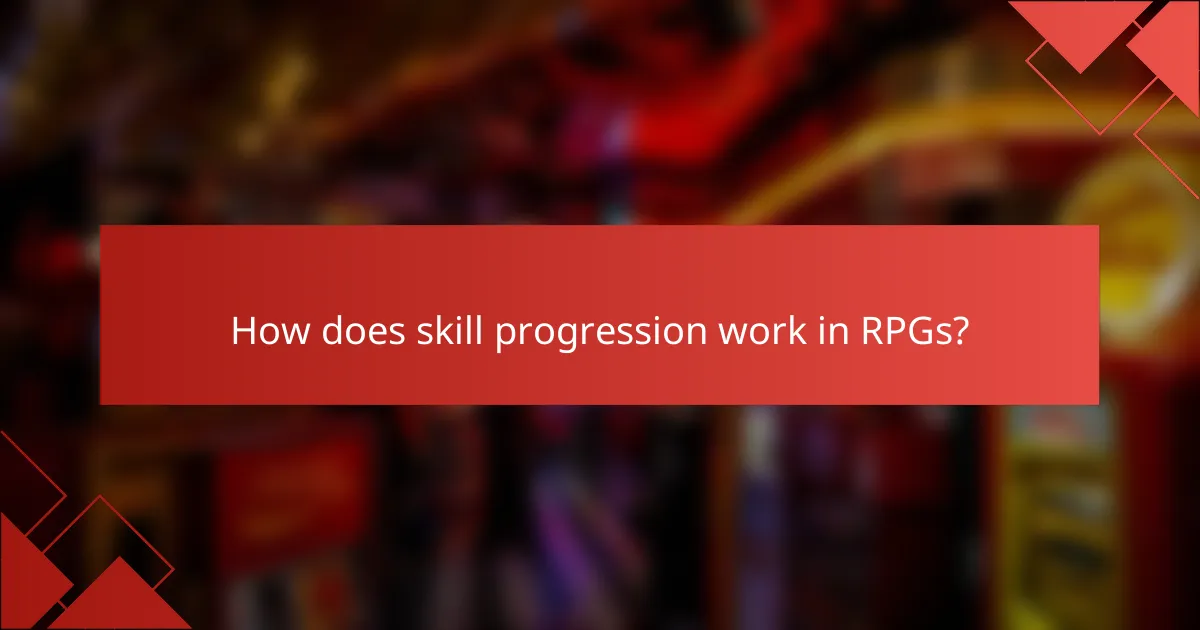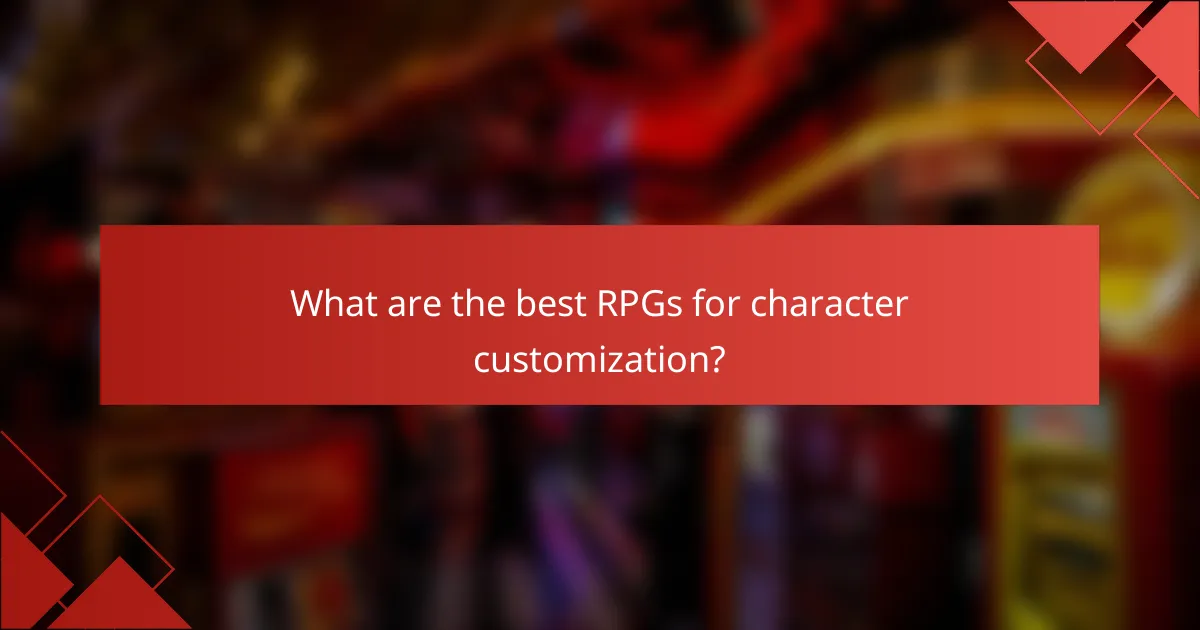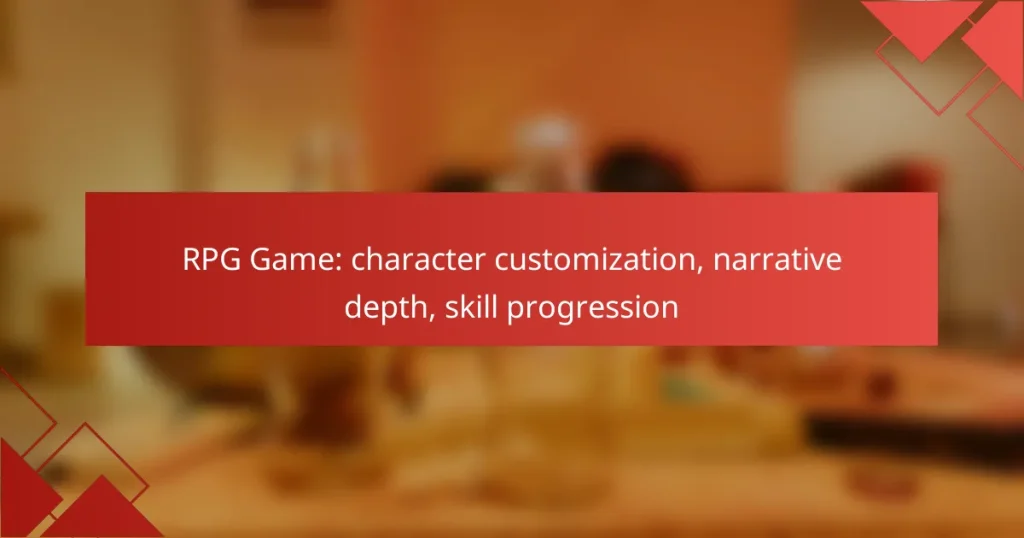Character customization in RPG games allows players to shape their avatars’ appearance, abilities, and backgrounds, fostering a unique connection to the game world. By integrating rich narratives and meaningful player choices, these games enhance immersion and storytelling. Additionally, skill progression enables characters to evolve through experience gained from quests and challenges, further deepening the gameplay experience.

How to customize characters in RPG games?
Customizing characters in RPG games involves tailoring their appearance, abilities, and backgrounds to create a unique gaming experience. Players can influence various aspects, including visual traits, skill sets, and narrative roles, enhancing immersion and personal connection to the game.
Visual customization options
Visual customization options allow players to modify their character’s appearance, including features such as hair style, skin tone, clothing, and accessories. Many RPGs offer sliders and color palettes for detailed adjustments, enabling a personalized look that reflects the player’s style.
Some games provide preset templates for quick customization, while others encourage extensive modifications. Consider the balance between time spent customizing and gameplay; sometimes, a simple design can be just as effective as a complex one.
Stat allocation systems
Stat allocation systems determine how players distribute points across various attributes like strength, intelligence, and agility. Players often face choices that affect gameplay, such as specializing in combat or magic, which can lead to different playstyles and strategies.
Common systems include point-buy methods, where players have a set number of points to allocate, and class-based systems that automatically assign stats based on chosen roles. Understanding the implications of each system can help players make informed decisions that align with their desired gameplay experience.
Class and race selection
Class and race selection significantly impacts character abilities and narrative roles in RPGs. Each race may offer unique bonuses or traits, while classes define the character’s skills and playstyle, such as warrior, mage, or rogue.
Players should consider how class and race combinations can complement each other. For example, a high-dexterity elf rogue may excel in stealth and agility, while a sturdy dwarf warrior could be better suited for frontline combat. Choosing wisely can enhance both gameplay effectiveness and storytelling depth.
Examples from popular RPGs
Popular RPGs like “The Elder Scrolls V: Skyrim” offer extensive character customization, allowing players to choose from various races and classes, along with detailed visual options. “Final Fantasy XIV” provides a robust job system that lets players change classes while keeping their character’s appearance intact.
In “Cyberpunk 2077,” players can customize not only visual traits but also cybernetic enhancements, influencing gameplay and story outcomes. Each of these games showcases different approaches to character customization, highlighting the importance of player choice in shaping the gaming experience.

What are the key narrative elements in RPGs?
The key narrative elements in RPGs include character backstory integration, player choice impact, and world-building techniques. These elements work together to create immersive experiences that engage players and enhance storytelling.
Character backstory integration
Character backstory integration involves weaving a player’s personal history into the game’s narrative. This can enhance emotional investment and provide context for character motivations and actions. For example, a character who lost a family member to a villain may have a personal vendetta that drives their choices throughout the game.
To effectively integrate backstories, developers should allow players to create or select backgrounds that influence gameplay. This could include unique quests or dialogue options based on the character’s history, enriching the overall experience.
Player choice impact
Player choice impact refers to how decisions made by players affect the game’s narrative and world. Choices can lead to different story outcomes, character relationships, and even changes in the game environment. This dynamic encourages players to think critically about their actions and their consequences.
To maximize player choice impact, RPGs should offer meaningful options that lead to varied endings or character arcs. For instance, a player might choose to ally with a faction, which could result in different resources or quests becoming available, significantly altering their gameplay experience.
World-building techniques
World-building techniques are essential for creating a believable and immersive game universe. This includes developing rich lore, diverse cultures, and intricate histories that players can explore. Effective world-building invites players to engage with the environment and discover its secrets.
Developers can enhance world-building through detailed descriptions, interactive environments, and NPCs with unique stories. For example, including ancient ruins with lore-based quests can encourage exploration and deepen players’ connection to the game world.

How does skill progression work in RPGs?
Skill progression in RPGs involves the development and enhancement of a character’s abilities as they gain experience through gameplay. Players typically improve their skills by completing quests, defeating enemies, or engaging in various activities that align with their character’s class or role.
Experience points systems
Experience points (XP) systems are foundational to skill progression in RPGs. Players earn XP by accomplishing tasks, such as defeating monsters or completing quests, which contributes to their overall level. The amount of XP required to level up usually increases with each level, creating a sense of achievement as players progress.
For example, a player might need a few hundred XP to reach level 2, but several thousand to reach level 3. This exponential growth encourages players to engage with the game world more deeply to earn the necessary points.
Skill trees and branching paths
Skill trees provide a visual representation of a character’s abilities and potential growth paths. Players can invest points into specific skills, unlocking new abilities or enhancing existing ones. This system allows for customization, enabling players to tailor their characters to fit their preferred playstyle.
Branching paths in skill trees often present trade-offs; choosing one skill may lock out others, encouraging strategic decision-making. For instance, a warrior might choose between a defensive skill that increases armor or an offensive skill that boosts attack power, impacting their overall effectiveness in combat.
Leveling mechanics in top RPGs
Top RPGs employ various leveling mechanics to enhance player engagement and satisfaction. Some games use a traditional level cap, while others allow for continuous progression without limits. Additionally, many RPGs incorporate milestones, such as unlocking new areas or abilities at specific levels, to keep players motivated.
Common pitfalls include overemphasis on grinding for XP, which can lead to player fatigue. Instead, focus on diverse activities that reward players with XP, ensuring a balanced and enjoyable progression experience. Games like “The Witcher” and “Final Fantasy” exemplify effective leveling mechanics by integrating story-driven quests with skill progression, making the journey as rewarding as the destination.

What are the best RPGs for character customization?
The best RPGs for character customization allow players to tailor their avatars in unique ways, enhancing personal expression and gameplay experience. Titles like Cyberpunk 2077, The Elder Scrolls V: Skyrim, and Final Fantasy XIV offer extensive options for modifying appearance, skills, and roles.
Cyberpunk 2077 customization features
Cyberpunk 2077 provides a robust character customization system that includes options for physical appearance, skills, and cybernetic enhancements. Players can choose from various body types, hairstyles, and tattoos, allowing for a highly personalized avatar.
Additionally, the game features a detailed skill tree where players can invest points into attributes such as intelligence, reflexes, and technical ability. This system encourages players to develop unique playstyles, whether focusing on stealth, hacking, or combat.
The Elder Scrolls V: Skyrim character options
In The Elder Scrolls V: Skyrim, character customization begins with selecting a race, each offering distinct abilities and bonuses. Players can further customize their character’s appearance through facial features, hairstyles, and body types, creating a unique hero in the expansive world of Tamriel.
Skyrim also features a skill progression system where players can develop skills in various areas such as combat, magic, and crafting. This flexibility allows players to adapt their characters to different playstyles, enhancing the overall gaming experience.
Final Fantasy XIV job system
Final Fantasy XIV utilizes a job system that allows players to switch between different roles, such as tank, healer, or damage dealer, depending on their preferences. Each job has its own set of skills and abilities, providing a diverse gameplay experience.
Character customization in Final Fantasy XIV includes options for appearance, as well as the ability to level up different jobs independently. This encourages players to explore various roles and find the one that best suits their playstyle, making the game highly replayable.

How do narrative choices affect gameplay?
Narrative choices significantly influence gameplay by shaping character development, altering story arcs, and affecting player relationships within the game world. These decisions can lead to various outcomes, impacting both immediate gameplay and long-term progression.
Consequences of player decisions
Player decisions in RPGs often lead to tangible consequences that can alter the course of the game. For instance, choosing to ally with one faction over another may grant unique quests or items while closing off opportunities with rival factions. This creates a dynamic experience where each choice can lead to different gameplay scenarios.
It’s essential to consider the potential ramifications of your choices. Some decisions may seem minor at first but can snowball into significant changes later in the game. Players should weigh their options carefully, as certain paths may lead to beneficial alliances or dire conflicts.
Branching storylines in RPGs
Branching storylines are a hallmark of RPGs, allowing players to navigate through multiple narrative paths based on their choices. This structure enhances replayability, as players can explore different outcomes by making alternative decisions in subsequent playthroughs. Each branch can lead to unique quests, character interactions, and endings.
To fully experience the branching narratives, players should engage with various characters and explore different dialogue options. Keeping track of previous choices can help in understanding how to navigate the story effectively. Be aware that some choices may lock you out of certain storylines, so consider saving your game before making pivotal decisions.

What are the trends in RPG character customization?
Current trends in RPG character customization focus on enhancing player agency and immersion through detailed personalization options and dynamic systems. Players now expect to shape their characters not just visually, but also through complex narratives and skill progression that reflect their choices.
Emerging technologies in character design
Emerging technologies such as procedural generation and artificial intelligence are revolutionizing character design in RPGs. These technologies allow for more diverse and unique character appearances and traits, enabling players to create avatars that stand out in a crowded gaming landscape.
For instance, procedural generation can create a vast array of facial features, body types, and clothing options without requiring extensive manual design work. AI-driven systems can analyze player preferences and suggest character traits or backstories that align with their gameplay style, enhancing the overall experience.
Additionally, virtual reality (VR) and augmented reality (AR) are becoming more integrated into RPGs, allowing players to interact with their characters in immersive ways. This technology can provide a deeper connection to the character, making customization feel more impactful and personal.


